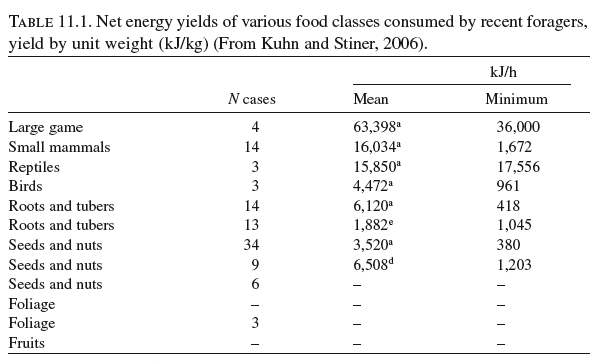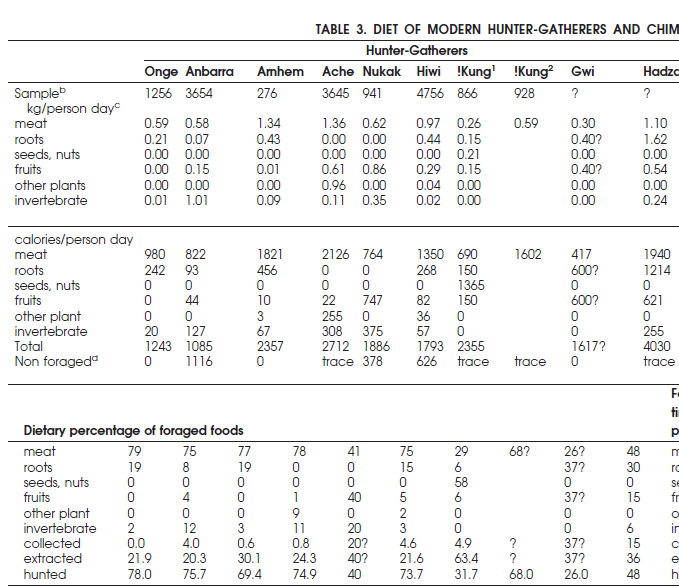From time to time a prominent Paleolithic researchers of one discipline or another remark, apparently in reference to popular Paleo dogma, that: “there were many Paleo diets” or that “there was no single Paleolithic diet”. The last one to do that was Prof. Daniel Lieberman of Harvard, the opening speaker of AHS12.
Some Paleo leaders like Robb Wolf and Chris Kresser were quick to repeat the message so I thought it might be of interest to examine the relevance of this statement more closely.
In short, in my opinion, the past variability of the Paleolithic diet, although true to some limited extent, is quite irrelevant in the context of a Paleo diet as commonly practiced today.
For those not interested in the details – The most common and most significant components of the Homo Paleolithic diet, throughout human evolution were meat and fat. Reading some of Lieberman work I believe he may support this statement. After all, in an interesting paper he has recently written he claims that the transition from Australopithecus to Homo involved changing the Homo energy source to include a significant component of meat as is attested by his changed body composition as well as his large brain, adaptations that seems to prepare him to hunt animals.
In contrast to plant food, meat and fat were and are practically nutritionally identical in every prey species, anywhere, anytime. The variability than could only be in the particular plant foods that composed the rest of the diet in different Paleolithic times and spaces. I would argue that none of these plant foods is available today in its natural form and those domesticated species that are available are almost invariably poorly pre-processed to the extent that they pose a safety hazard. Therefor a Paleo diet that contains mainly meat, animal fat and a limited component of vegetables that do not require pre-processing is optimal, i.e. the least unsafe. To conclude, Paleo diet variability, to the extent that it existed in the Paleolithic in its plant component, is quite irrelevant to present Paleo diet followers.
How varied and how plant intensive were Paleo diets anyway?
Despite what some experts may say there is no shortage of information on the Homo diet throughout our evolution. Here is a list of sources of information and the conclusions one can draw from them:
Archaeology: Archaeological sites from 2.0 million years and onward until 0.012 million years (12 thousand years) or so in the Levant and until later in other areas almost always contain bones of large animals, many of them crashed in order to extract marrow. Stone tools were mostly designed to hunt and cut meat. Remains of seeds and other starchy plants in teeth calculus indicate an unquantifiable consumption of various plants however no stone tools for plant food processing are found. When they finally do appear in the Upper Paleolithic they increase in prevalence in each period leading to and including the Neolithic (Agriculture) (1) indicating significant seed consumption from 12 thousand years but by inference not before.
There is evidence for significant consumption of nuts. Stones anvil used for nut cracking dated to 780 thousand years was found in Gesher B’not Yaacov (GBY) in Israel. Other plant species like olives and figs were also identified in GBY. In Dederiya, Syria, 14-13 thousand years ago, nearly 90% of the 12,000 plant fragments come from pistachio and almond trees (2). So the archaeological evidence says that yes, plant food was always consumed but it doesn’t seems to have been significant enough to warrant the development of stone tools for its processing until sedentism began 20-10 thousand years ago in the Fertile Crescent and much later in other parts of the world.
Nitrogen Stable Isotope – The relative concentration of the isotope in the bones indicates trophic level of the animal examined. All (100%) of tested humans from Upper Paleolithic Europe prior to agriculture show a level that is comparable to that of top-level carnivores (3). Omnivores like the Brown Bear do show as omnivores in these stable isotope studies. Humans don’t.
Ethnography – If used with caution ethnography can be considered as a good simulation of Paleolithic hunter-gatherers’ (HG) constrains and solutions. Here is a table showing the relative efficiency of hunting Vis a Vis gathering.
 As you can see hunting is 10 times more efficient than gathering in terms of energy per time invested. It should be noted that in earlier periods larger animals would have been available and therefore hunting could have been even more time efficient. As can be expected from the above, HG groups generally consume much more meat than plants. It is not easy for anthropologists to arrive at an exact diet composition of a group of HG. A good sample of people have to be followed 24/7 for a reasonable amount of days during the various seasons and most cumbersome of all, food must be weighed or measured each time prior to actual consumption by the followed individual.
As you can see hunting is 10 times more efficient than gathering in terms of energy per time invested. It should be noted that in earlier periods larger animals would have been available and therefore hunting could have been even more time efficient. As can be expected from the above, HG groups generally consume much more meat than plants. It is not easy for anthropologists to arrive at an exact diet composition of a group of HG. A good sample of people have to be followed 24/7 for a reasonable amount of days during the various seasons and most cumbersome of all, food must be weighed or measured each time prior to actual consumption by the followed individual.
 Kaplan et al (5) looked for every study of this caliber they could find and came up with 8 studies where sufficient data was available. Here is the table (the botom section). If we include invertebrate in the meat category five of the eight groups got 78-89% of their calories from meat. One group, the Nukak, got 61% of the calories from meat and most of the rest from palm oil fruit while the !Kung probably got a sizable amount of their plant calories from Magongo nuts.
Kaplan et al (5) looked for every study of this caliber they could find and came up with 8 studies where sufficient data was available. Here is the table (the botom section). If we include invertebrate in the meat category five of the eight groups got 78-89% of their calories from meat. One group, the Nukak, got 61% of the calories from meat and most of the rest from palm oil fruit while the !Kung probably got a sizable amount of their plant calories from Magongo nuts.
To sum up, the ethnographic record also supports predominantly high meat and fat diet while plant food shows a tendency towards high fat fruit and nuts.
Genetics – Genetic studies also indicate that plant food consumption was rather limited until quite recently. Perry’s amylase study (6) is always cited as a proof that we are adapted to consume starch but the timing of the increased amylase genes copies is not certain (within the last ~200 thousand years) and the multiple gene copies prevalence vary within present human groups. Hancock et al. (4) report that recent relevant genetic adaptations are evident in groups that consume plenty of starch in the form of Underground Storage Organs (ISO). The fact that these adaptations are recent and other groups don’t have them pull the carpet under the arguments of those like Wrangham (The Cocking Hypothesis) (7,8) who argued for a significant Paleolithic consumption of ISOs. The reason many pro-plant researchers hanged their coats on ISOs was that there are very few high quality plant food beside them in nature, especially starchy ones. Most of the organic energy in nature is stored in fiber (trees and other plants) some of it in starch (seeds, fruits and ISOs) some as protein (legumes) and some of it in fats (nuts and some fruits). No wander nuts are so visible in the archaeological record. Seeds by the way do appear in great variety but there is no indication that they ever formed a significant part of the diet. Seeds have extremely short season and can’t be stored in the context of nomadic HG lifestyle. Here too genetic data that indicate recent and partial adaptation to significant starch consumption (4,6) is continually ignored by experts like these.
In summary, quantitatively significant potential plant sources for Paleolithic diets are limited and we were not adapted to consume them in large quantities. There is no evidence for plant-dominated diet in our pre-agricultural human past and certainly not in present day HG groups in places where animals are as abundant as they were in Paleolithic times. On the other hand there is substantial evidence that meat and fat were always the major components of the human diet. If that is the case how different could the various Paleo diets be?
- Wright, K. (1991). The Origins and development of ground stone assemblages in Late Pleistocene Southwest Asia. Paléorient, 17(1), 19-45
- Balter , M (2010) The Tangled Roots of Agriculture, Nature
- Richards MP, Trinkaus E (2009) Isotopic evidence for the diets of European Neanderthals and early modern humans. Proc Natl Acad Sci U S A 106: 16034-16039.
- Hancock AM, Witonsky DB, Ehler E, Alkorta-Aranburu G, Beall C, et al. (2010) Colloquium paper: Human adaptations to diet, subsistence, and ecoregion are due to subtle shifts in allele frequency. Proc Natl Acad Sci U S A 107: 8924-8930.
- Kaplan, H., Hill, K., Lancaster, J., & Hurtado, A. M. (2000). A theory of human life history evolution: Diet, intelligence, and longevity. Evolutionary Anthropology,9(4), 156-185
- Perry GH, Dominy NJ, Claw KG, Lee AS, Fiegler H, et al. (2007) Diet and the evolution of human amylase gene copy number variation. Nature Genetics 39(10): 1256–1260
- Wrangham R, Carmody RN (2010) Human adaptation to the control of fire. Evolutionary Anthropology: Issues, News and Reviews 19(5): 187–199.
- Wrangham RW, Jones JH, Laden G, Pilbeam D, Conklin-Brittain N (1999) The raw and the stolen: cooking and the ecology of human origins. Current Anthropology 40(5): 567–594.







 I am a Ph.D. in archaeology, affiliated with the department of Archaeology of Tel Aviv University. I research the connection between human evolution and nutrition throughout human prehistory.
I am a Ph.D. in archaeology, affiliated with the department of Archaeology of Tel Aviv University. I research the connection between human evolution and nutrition throughout human prehistory.

Pingback: How varied could past Paleo diets have been and does it really matter?